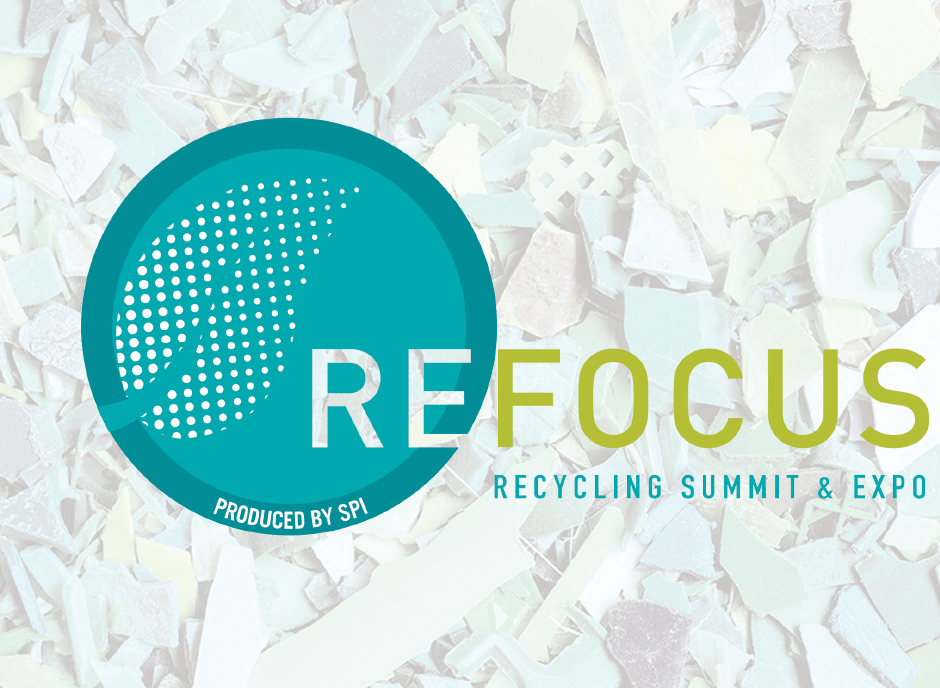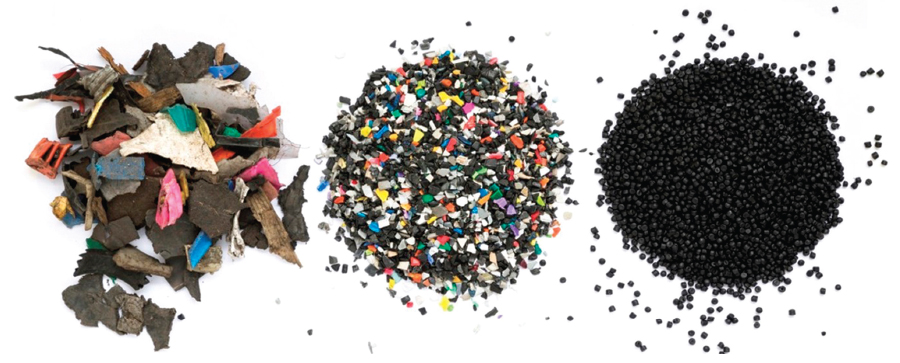Sustainability: Big Challenges, Big Solutions
Re/focus presenters describe the biggest sustainability challenges facing the plastics industry today—and what to do about them
Previous Article Next Article

Graphics courtesy of SPI.
Ahead of the Re|focus Recycling Summit & Expo, SPI asked some of the event’s speakers one important question: “What do you think is the biggest challenge facing sustainability in the plastics industry today, and what will it take to overcome it?” Here are some of their responses, many of which boil down to one common factor: the importance of reaching consumers in any effort to extract value from plastics throughout their life cycle.

Vicki Worden, Green Building Initiative
“The plastics industry has done a great job employing research and innovation to create products that have made consumer goods and market segments more sustainable. However, the industry continues to face public perception challenges, perhaps termed best as consumer guilt.
“The successful track record of the industry in reducing emissions, increasing recyclability and reuse, and minimizing the use of fossil fuels in production are all examples of continuous improvement and messages that consumers need to consistently be hearing. Consumers also need better information on what can be recycled or reused, and education on the many secondary markets that have been created worldwide. Ongoing focus on delivering messages about the continuous improvement of the industry would be extremely beneficial to minimizing consumer guilt.”

Levi Stewart, Sustainability Accounting Standards Board
“The predominant sustainability challenge facing the plastics industry today is balancing the impacts associated with product lifecycle management amid falling oil and
natural gas prices. Considering product lifecycle management as the ability to minimize the environmental impacts of packaging, companies may seek to develop packaging products from recycled and/or renewable materials that are also recyclable, reusable, and/or biodegradable.
“Understanding that falling oil and natural gas prices reduce the cost of virgin plastic resins, plastics producers may find the economics difficult to develop cost-effective solutions to the challenges presented through product lifecycle management. Overcoming this challenge will require improvements to the current recycling infrastructure and increased consumer demand for products with reduced lifecycle impacts.”

Jeff Wooster, The Dow Chemical Company
“The biggest sustainability challenge our industry faces is one of focus. Not the focus of business, government, or other organizations on sustainability, but the focus of consumers. U.S. consumers are currently too focused on a single element of sustainability: recycling. They see low recycling rates for plastics and think that plastics have poor sustainability performance because they aren’t recycled at the same rates as materials that have been in the marketplace for much longer.
“To overcome this challenge we need to do two things. First, we need to help our value chain, industry influencers, community leaders, and average citizens understand that plastics have many sustainability advantages. They are lightweight, durable, and versatile and meet many different consumer needs in a very resource-efficient manner.
“Second, we need to increase the recycling and recovery of all types of plastics. We need to increase conventional mechanical recycling rates for materials that are already recycled, and we need to expand capabilities to capture value from non-recycled plastic products via chemical transformation, energy recovery, and other emerging technologies.”

Tod Christenson, Healthcare Plastics Recycling Council (HPRC)
“Creating a sustainable and circular economy for plastic packaging and product resources. Short of a plastic resource availability crisis, it will take a combination of prudent policy (i.e., incentive) and collaboration on the part of industry to develop common, consistent packaging and product formats to enable re-use and upcycling at end of life. This reduces carbon contributions and minimizes global waste and litter.”

Richard Krock, Vinyl Institute
“First, investment must be increased in U.S. and international plastics industry infrastructure to recover, recycle, or convert end of life plastics to new materials or energy. Without more facilities and greater capabilities at existing facilities, many valuable resources in the form of waste plastics will be lost. The variable relationship between energy prices and recovered plastics values has hindered growth in plastics recovery infrastructure. As a result, many original equipment manufacturers (OEMs) and consumers do not fully comprehend the true value that recovered plastics bring to society.
“Second, more information must be provided to consumers and OEMs about the value that plastics provide to society. Typically, by the time the plastic application has reached the end of its useful life, many benefits have already been realized, such as energy savings, water conservation, food preservation, and other natural resource conservation and environmental benefits. This can only be accomplished through informative and steady communications programs.”

Robert Peoples, Carpet America Recovery Effort (CARE)
“The biggest threat facing the recycling world today is the price of oil. The dramatic fall from $105 per barrel to under $30 has sent shock waves through the global recycling community. In my world, the carpet recycling industry, we have seen the value and demand for post-consumer derived polymers drop in some cases below the price of virgin chip.
“While anyone with experience knows we go through cycles, this time is different. The rapid drop in oil [prices], coupled with what looks to be a prolonged period of low oil prices, is causing businesses to contract or shut down at an increasing pace. In an effort to offset this price/demand imbalance, CARE has implemented increased subsidies in California. As a result, … post-consumer carpet and fiber are moving across the country and impact the infrastructure outside California.
“The pricing challenges have been further exacerbated by a loss of nylon 6 capacity in the U.S., the slowdown in the Chinese economy, and the fact that Iran is now pumping oil into the supply chain to raise cash after years of sanctions. How do we overcome these changes? There are no easy answers or silver bullets here. Cutting subsidies for oil is one possibility, and using procurement leverage to buy products containing post-consumer content could help. But it is not clear how quickly such changes could be implemented and how much damage will occur in the interim.”
The Nuts & Bolts of Sustainability
SPE and its Sustainability Division are sponsoring the “Engineering” track of sessions at Re|focus, and Plastics Engineering asked a few of those speakers about their talk’s topic, why it’s important, and what key points the audience will take away from their presentation (see all of this track’s speakers at www.refocussummit.org/speaker/engineering-track).
PE also asked two other presenters about their topics on how to reuse more material from less-often-recycled plastics streams.

James Mitchell, Solvay Engineering Plastics
“[I’ll speak on] how to develop high quality and sustainable recycled polyamide grades for the automotive industry. The sourcing of quality recycled engineering plastics is very difficult. Very low quality recycled grades which contain all sorts of additive systems are easy to source but very difficult to use and almost impossible to specify. Reuse of waste from production is the best way to guarantee specification, but it’s difficult for planning and limited in volume.
“The best way to move forward is to source sustainable end parts to provide highly consistent and volume-guaranteed products for use in high-quality recycled compounds. However, there are not so many high-volume consistent uses where it is simple and makes economic sense to fully recycle and use [the material] again in new applications. One such application where it is possible is with PET bottles, while another is with PA66 from air bags or other textile fiber or fiber scraps.
“Recycling high-quality products is very difficult! ... [Solvay’s] Technyl answer to this problem is to depolymerize scraps from these fiber parts to gain a finished base polymer that is extremely close in performance to its virgin counterpart. This material can then be used in any application and can be guaranteed to be fully recycled and fully capable for the demanding needs of under-the-bonnet auto applications. … This type of recycling is the future for recycling, and with our new high-quality range of Technyl-4-Earth products, we will be able to provide a sustainable recycled solution for our customers globally.”

Charlie Martin, Leistritz
“[My talk is tentatively titled:] ‘Integrating Compounding Twin Screw Extruders into PCR/PIR Reclaim.’ Adding value to recycled materials, in addition to merely reclaiming waste materials, is possible but not common. Co-rotating, intermeshing twin screw extruders (TSEs) are used for the compounding of fillers and additives into a plastic, as well as for the devolatilization of moisture and other undesirable volatiles from the process melt stream. There is a trend to integrate compounding and devolatilization functionalities into reclaim extrusion systems using TSEs to make value-added products from recycled materials.
“This presentation will describe the process tasks involved in feeding, cleaning, and compounding of PIR [post-industrial reclaim] and PCR [post-consumer reclaim] feedstocks to make value-added products in a one-step manufacturing operation. New and unique TSE reclaim systems that integrate proven technologies into atypical TSE systems are available to compound recycled materials with fillers, fibers, and additives with PIR and PCR materials to make high-value parts. Understanding the feedstock materials, final product property requirements, careful staging of unit operations, integration of the correct equipment, and system controls must all be addressed for a successful value-added reclaim installation.”

Tamsin Ettefagh, Envision Plastics
“[My talk’s title is:] ‘FDA Compliant 100% Post-Consumer HDPE: How we got there and end uses for the resin today.’ I was asked to speak on this, so I believe SPI is looking for the value [of this material] in diversified markets, as well as the ability to go from bottle to bottle with the challenges of the quality of supply today.
“There has been an assumption by those that understand the science of HDPE that it cannot achieve FDA compliance due to the nature of HDPE. [It] loves to absorb most volatiles, and HDPE is a common resin used for household chemicals. I hope to dispel that and encourage other end uses to get [people more] comfortable with using recycling in direct food packaging.”

Scott Steele, Plastic Technologies, Inc.
“[My talk is tentatively titled:] ‘Identifying Obstacles and Solutions to Using rPET for Next-Generation Bottles.’ Using recycled polyethylene terephthalate (rPET) resin as a material source for 100% recycled-content bottles is something that many companies are exploring. However, what is frequently not taken into account are the realities of the supply chain for rPET. Looking at the attributes of individual packaging components (adhesives, additives, labels, closures, liners, colorants, etc.) and activities (exposure to UV light, storage, etc.) will enable appropriate decisions to be made earlier in the life cycle. The goal is to positively impact the recycling stream and future bottle generations.
“[I’ll] present issues facing users of recycled resins and some of the new technologies on the horizon that present challenges and opportunities for the industry.”

Brian Riise, MBA Polymers
“I will be talking about the plastics recovered from shredded end-of-life vehicles at the MBA Polymers facility in the United Kingdom. The technologies used to recover these
plastics were initially developed to recover plastics from waste electronics (as is currently practiced in our plants in China and Austria). The talk will also show that widespread application of such technologies could enable the diversion of over 1 million tons per year of plastics from end-of-life vehicles from U.S. landfills into new plastic products. Such products could include plastic parts for new automobiles.
“Recycled plastics from steams such as waste electronics and end-of-life vehicles provide an environmental benefit compared with using virgin plastics. By the end of the talk, I would like the audience to understand how the selection of plastics and other raw materials for use in automobiles can affect the availability of high-quality recycled plastics from future end-of-life vehicles.”

Image courtesy of MBA Polymers.
Sustainability: Big Challenges, Big Solutions
Re/focus presenters describe the biggest sustainability challenges facing the plastics industry today—and what to do about them
Previous Article Next Article

Graphics courtesy of SPI.
Ahead of the Re|focus Recycling Summit & Expo, SPI asked some of the event’s speakers one important question: “What do you think is the biggest challenge facing sustainability in the plastics industry today, and what will it take to overcome it?” Here are some of their responses, many of which boil down to one common factor: the importance of reaching consumers in any effort to extract value from plastics throughout their life cycle.

Vicki Worden, Green Building Initiative
“The plastics industry has done a great job employing research and innovation to create products that have made consumer goods and market segments more sustainable. However, the industry continues to face public perception challenges, perhaps termed best as consumer guilt.
“The successful track record of the industry in reducing emissions, increasing recyclability and reuse, and minimizing the use of fossil fuels in production are all examples of continuous improvement and messages that consumers need to consistently be hearing. Consumers also need better information on what can be recycled or reused, and education on the many secondary markets that have been created worldwide. Ongoing focus on delivering messages about the continuous improvement of the industry would be extremely beneficial to minimizing consumer guilt.”

Levi Stewart, Sustainability Accounting Standards Board
“The predominant sustainability challenge facing the plastics industry today is balancing the impacts associated with product lifecycle management amid falling oil and
natural gas prices. Considering product lifecycle management as the ability to minimize the environmental impacts of packaging, companies may seek to develop packaging products from recycled and/or renewable materials that are also recyclable, reusable, and/or biodegradable.
“Understanding that falling oil and natural gas prices reduce the cost of virgin plastic resins, plastics producers may find the economics difficult to develop cost-effective solutions to the challenges presented through product lifecycle management. Overcoming this challenge will require improvements to the current recycling infrastructure and increased consumer demand for products with reduced lifecycle impacts.”

Jeff Wooster, The Dow Chemical Company
“The biggest sustainability challenge our industry faces is one of focus. Not the focus of business, government, or other organizations on sustainability, but the focus of consumers. U.S. consumers are currently too focused on a single element of sustainability: recycling. They see low recycling rates for plastics and think that plastics have poor sustainability performance because they aren’t recycled at the same rates as materials that have been in the marketplace for much longer.
“To overcome this challenge we need to do two things. First, we need to help our value chain, industry influencers, community leaders, and average citizens understand that plastics have many sustainability advantages. They are lightweight, durable, and versatile and meet many different consumer needs in a very resource-efficient manner.
“Second, we need to increase the recycling and recovery of all types of plastics. We need to increase conventional mechanical recycling rates for materials that are already recycled, and we need to expand capabilities to capture value from non-recycled plastic products via chemical transformation, energy recovery, and other emerging technologies.”

Tod Christenson, Healthcare Plastics Recycling Council (HPRC)
“Creating a sustainable and circular economy for plastic packaging and product resources. Short of a plastic resource availability crisis, it will take a combination of prudent policy (i.e., incentive) and collaboration on the part of industry to develop common, consistent packaging and product formats to enable re-use and upcycling at end of life. This reduces carbon contributions and minimizes global waste and litter.”

Richard Krock, Vinyl Institute
“First, investment must be increased in U.S. and international plastics industry infrastructure to recover, recycle, or convert end of life plastics to new materials or energy. Without more facilities and greater capabilities at existing facilities, many valuable resources in the form of waste plastics will be lost. The variable relationship between energy prices and recovered plastics values has hindered growth in plastics recovery infrastructure. As a result, many original equipment manufacturers (OEMs) and consumers do not fully comprehend the true value that recovered plastics bring to society.
“Second, more information must be provided to consumers and OEMs about the value that plastics provide to society. Typically, by the time the plastic application has reached the end of its useful life, many benefits have already been realized, such as energy savings, water conservation, food preservation, and other natural resource conservation and environmental benefits. This can only be accomplished through informative and steady communications programs.”

Robert Peoples, Carpet America Recovery Effort (CARE)
“The biggest threat facing the recycling world today is the price of oil. The dramatic fall from $105 per barrel to under $30 has sent shock waves through the global recycling community. In my world, the carpet recycling industry, we have seen the value and demand for post-consumer derived polymers drop in some cases below the price of virgin chip.
“While anyone with experience knows we go through cycles, this time is different. The rapid drop in oil [prices], coupled with what looks to be a prolonged period of low oil prices, is causing businesses to contract or shut down at an increasing pace. In an effort to offset this price/demand imbalance, CARE has implemented increased subsidies in California. As a result, … post-consumer carpet and fiber are moving across the country and impact the infrastructure outside California.
“The pricing challenges have been further exacerbated by a loss of nylon 6 capacity in the U.S., the slowdown in the Chinese economy, and the fact that Iran is now pumping oil into the supply chain to raise cash after years of sanctions. How do we overcome these changes? There are no easy answers or silver bullets here. Cutting subsidies for oil is one possibility, and using procurement leverage to buy products containing post-consumer content could help. But it is not clear how quickly such changes could be implemented and how much damage will occur in the interim.”
The Nuts & Bolts of Sustainability
SPE and its Sustainability Division are sponsoring the “Engineering” track of sessions at Re|focus, and Plastics Engineering asked a few of those speakers about their talk’s topic, why it’s important, and what key points the audience will take away from their presentation (see all of this track’s speakers at www.refocussummit.org/speaker/engineering-track).
PE also asked two other presenters about their topics on how to reuse more material from less-often-recycled plastics streams.

James Mitchell, Solvay Engineering Plastics
“[I’ll speak on] how to develop high quality and sustainable recycled polyamide grades for the automotive industry. The sourcing of quality recycled engineering plastics is very difficult. Very low quality recycled grades which contain all sorts of additive systems are easy to source but very difficult to use and almost impossible to specify. Reuse of waste from production is the best way to guarantee specification, but it’s difficult for planning and limited in volume.
“The best way to move forward is to source sustainable end parts to provide highly consistent and volume-guaranteed products for use in high-quality recycled compounds. However, there are not so many high-volume consistent uses where it is simple and makes economic sense to fully recycle and use [the material] again in new applications. One such application where it is possible is with PET bottles, while another is with PA66 from air bags or other textile fiber or fiber scraps.
“Recycling high-quality products is very difficult! ... [Solvay’s] Technyl answer to this problem is to depolymerize scraps from these fiber parts to gain a finished base polymer that is extremely close in performance to its virgin counterpart. This material can then be used in any application and can be guaranteed to be fully recycled and fully capable for the demanding needs of under-the-bonnet auto applications. … This type of recycling is the future for recycling, and with our new high-quality range of Technyl-4-Earth products, we will be able to provide a sustainable recycled solution for our customers globally.”

Charlie Martin, Leistritz
“[My talk is tentatively titled:] ‘Integrating Compounding Twin Screw Extruders into PCR/PIR Reclaim.’ Adding value to recycled materials, in addition to merely reclaiming waste materials, is possible but not common. Co-rotating, intermeshing twin screw extruders (TSEs) are used for the compounding of fillers and additives into a plastic, as well as for the devolatilization of moisture and other undesirable volatiles from the process melt stream. There is a trend to integrate compounding and devolatilization functionalities into reclaim extrusion systems using TSEs to make value-added products from recycled materials.
“This presentation will describe the process tasks involved in feeding, cleaning, and compounding of PIR [post-industrial reclaim] and PCR [post-consumer reclaim] feedstocks to make value-added products in a one-step manufacturing operation. New and unique TSE reclaim systems that integrate proven technologies into atypical TSE systems are available to compound recycled materials with fillers, fibers, and additives with PIR and PCR materials to make high-value parts. Understanding the feedstock materials, final product property requirements, careful staging of unit operations, integration of the correct equipment, and system controls must all be addressed for a successful value-added reclaim installation.”

Tamsin Ettefagh, Envision Plastics
“[My talk’s title is:] ‘FDA Compliant 100% Post-Consumer HDPE: How we got there and end uses for the resin today.’ I was asked to speak on this, so I believe SPI is looking for the value [of this material] in diversified markets, as well as the ability to go from bottle to bottle with the challenges of the quality of supply today.
“There has been an assumption by those that understand the science of HDPE that it cannot achieve FDA compliance due to the nature of HDPE. [It] loves to absorb most volatiles, and HDPE is a common resin used for household chemicals. I hope to dispel that and encourage other end uses to get [people more] comfortable with using recycling in direct food packaging.”

Scott Steele, Plastic Technologies, Inc.
“[My talk is tentatively titled:] ‘Identifying Obstacles and Solutions to Using rPET for Next-Generation Bottles.’ Using recycled polyethylene terephthalate (rPET) resin as a material source for 100% recycled-content bottles is something that many companies are exploring. However, what is frequently not taken into account are the realities of the supply chain for rPET. Looking at the attributes of individual packaging components (adhesives, additives, labels, closures, liners, colorants, etc.) and activities (exposure to UV light, storage, etc.) will enable appropriate decisions to be made earlier in the life cycle. The goal is to positively impact the recycling stream and future bottle generations.
“[I’ll] present issues facing users of recycled resins and some of the new technologies on the horizon that present challenges and opportunities for the industry.”

Brian Riise, MBA Polymers
“I will be talking about the plastics recovered from shredded end-of-life vehicles at the MBA Polymers facility in the United Kingdom. The technologies used to recover these
plastics were initially developed to recover plastics from waste electronics (as is currently practiced in our plants in China and Austria). The talk will also show that widespread application of such technologies could enable the diversion of over 1 million tons per year of plastics from end-of-life vehicles from U.S. landfills into new plastic products. Such products could include plastic parts for new automobiles.
“Recycled plastics from steams such as waste electronics and end-of-life vehicles provide an environmental benefit compared with using virgin plastics. By the end of the talk, I would like the audience to understand how the selection of plastics and other raw materials for use in automobiles can affect the availability of high-quality recycled plastics from future end-of-life vehicles.”

Image courtesy of MBA Polymers.
Sustainability: Big Challenges, Big Solutions
Re/focus presenters describe the biggest sustainability challenges facing the plastics industry today—and what to do about them
Previous Article Next Article

Graphics courtesy of SPI.
Ahead of the Re|focus Recycling Summit & Expo, SPI asked some of the event’s speakers one important question: “What do you think is the biggest challenge facing sustainability in the plastics industry today, and what will it take to overcome it?” Here are some of their responses, many of which boil down to one common factor: the importance of reaching consumers in any effort to extract value from plastics throughout their life cycle.

Vicki Worden, Green Building Initiative
“The plastics industry has done a great job employing research and innovation to create products that have made consumer goods and market segments more sustainable. However, the industry continues to face public perception challenges, perhaps termed best as consumer guilt.
“The successful track record of the industry in reducing emissions, increasing recyclability and reuse, and minimizing the use of fossil fuels in production are all examples of continuous improvement and messages that consumers need to consistently be hearing. Consumers also need better information on what can be recycled or reused, and education on the many secondary markets that have been created worldwide. Ongoing focus on delivering messages about the continuous improvement of the industry would be extremely beneficial to minimizing consumer guilt.”

Levi Stewart, Sustainability Accounting Standards Board
“The predominant sustainability challenge facing the plastics industry today is balancing the impacts associated with product lifecycle management amid falling oil and
natural gas prices. Considering product lifecycle management as the ability to minimize the environmental impacts of packaging, companies may seek to develop packaging products from recycled and/or renewable materials that are also recyclable, reusable, and/or biodegradable.
“Understanding that falling oil and natural gas prices reduce the cost of virgin plastic resins, plastics producers may find the economics difficult to develop cost-effective solutions to the challenges presented through product lifecycle management. Overcoming this challenge will require improvements to the current recycling infrastructure and increased consumer demand for products with reduced lifecycle impacts.”

Jeff Wooster, The Dow Chemical Company
“The biggest sustainability challenge our industry faces is one of focus. Not the focus of business, government, or other organizations on sustainability, but the focus of consumers. U.S. consumers are currently too focused on a single element of sustainability: recycling. They see low recycling rates for plastics and think that plastics have poor sustainability performance because they aren’t recycled at the same rates as materials that have been in the marketplace for much longer.
“To overcome this challenge we need to do two things. First, we need to help our value chain, industry influencers, community leaders, and average citizens understand that plastics have many sustainability advantages. They are lightweight, durable, and versatile and meet many different consumer needs in a very resource-efficient manner.
“Second, we need to increase the recycling and recovery of all types of plastics. We need to increase conventional mechanical recycling rates for materials that are already recycled, and we need to expand capabilities to capture value from non-recycled plastic products via chemical transformation, energy recovery, and other emerging technologies.”

Tod Christenson, Healthcare Plastics Recycling Council (HPRC)
“Creating a sustainable and circular economy for plastic packaging and product resources. Short of a plastic resource availability crisis, it will take a combination of prudent policy (i.e., incentive) and collaboration on the part of industry to develop common, consistent packaging and product formats to enable re-use and upcycling at end of life. This reduces carbon contributions and minimizes global waste and litter.”

Richard Krock, Vinyl Institute
“First, investment must be increased in U.S. and international plastics industry infrastructure to recover, recycle, or convert end of life plastics to new materials or energy. Without more facilities and greater capabilities at existing facilities, many valuable resources in the form of waste plastics will be lost. The variable relationship between energy prices and recovered plastics values has hindered growth in plastics recovery infrastructure. As a result, many original equipment manufacturers (OEMs) and consumers do not fully comprehend the true value that recovered plastics bring to society.
“Second, more information must be provided to consumers and OEMs about the value that plastics provide to society. Typically, by the time the plastic application has reached the end of its useful life, many benefits have already been realized, such as energy savings, water conservation, food preservation, and other natural resource conservation and environmental benefits. This can only be accomplished through informative and steady communications programs.”

Robert Peoples, Carpet America Recovery Effort (CARE)
“The biggest threat facing the recycling world today is the price of oil. The dramatic fall from $105 per barrel to under $30 has sent shock waves through the global recycling community. In my world, the carpet recycling industry, we have seen the value and demand for post-consumer derived polymers drop in some cases below the price of virgin chip.
“While anyone with experience knows we go through cycles, this time is different. The rapid drop in oil [prices], coupled with what looks to be a prolonged period of low oil prices, is causing businesses to contract or shut down at an increasing pace. In an effort to offset this price/demand imbalance, CARE has implemented increased subsidies in California. As a result, … post-consumer carpet and fiber are moving across the country and impact the infrastructure outside California.
“The pricing challenges have been further exacerbated by a loss of nylon 6 capacity in the U.S., the slowdown in the Chinese economy, and the fact that Iran is now pumping oil into the supply chain to raise cash after years of sanctions. How do we overcome these changes? There are no easy answers or silver bullets here. Cutting subsidies for oil is one possibility, and using procurement leverage to buy products containing post-consumer content could help. But it is not clear how quickly such changes could be implemented and how much damage will occur in the interim.”
The Nuts & Bolts of Sustainability
SPE and its Sustainability Division are sponsoring the “Engineering” track of sessions at Re|focus, and Plastics Engineering asked a few of those speakers about their talk’s topic, why it’s important, and what key points the audience will take away from their presentation (see all of this track’s speakers at www.refocussummit.org/speaker/engineering-track).
PE also asked two other presenters about their topics on how to reuse more material from less-often-recycled plastics streams.

James Mitchell, Solvay Engineering Plastics
“[I’ll speak on] how to develop high quality and sustainable recycled polyamide grades for the automotive industry. The sourcing of quality recycled engineering plastics is very difficult. Very low quality recycled grades which contain all sorts of additive systems are easy to source but very difficult to use and almost impossible to specify. Reuse of waste from production is the best way to guarantee specification, but it’s difficult for planning and limited in volume.
“The best way to move forward is to source sustainable end parts to provide highly consistent and volume-guaranteed products for use in high-quality recycled compounds. However, there are not so many high-volume consistent uses where it is simple and makes economic sense to fully recycle and use [the material] again in new applications. One such application where it is possible is with PET bottles, while another is with PA66 from air bags or other textile fiber or fiber scraps.
“Recycling high-quality products is very difficult! ... [Solvay’s] Technyl answer to this problem is to depolymerize scraps from these fiber parts to gain a finished base polymer that is extremely close in performance to its virgin counterpart. This material can then be used in any application and can be guaranteed to be fully recycled and fully capable for the demanding needs of under-the-bonnet auto applications. … This type of recycling is the future for recycling, and with our new high-quality range of Technyl-4-Earth products, we will be able to provide a sustainable recycled solution for our customers globally.”

Charlie Martin, Leistritz
“[My talk is tentatively titled:] ‘Integrating Compounding Twin Screw Extruders into PCR/PIR Reclaim.’ Adding value to recycled materials, in addition to merely reclaiming waste materials, is possible but not common. Co-rotating, intermeshing twin screw extruders (TSEs) are used for the compounding of fillers and additives into a plastic, as well as for the devolatilization of moisture and other undesirable volatiles from the process melt stream. There is a trend to integrate compounding and devolatilization functionalities into reclaim extrusion systems using TSEs to make value-added products from recycled materials.
“This presentation will describe the process tasks involved in feeding, cleaning, and compounding of PIR [post-industrial reclaim] and PCR [post-consumer reclaim] feedstocks to make value-added products in a one-step manufacturing operation. New and unique TSE reclaim systems that integrate proven technologies into atypical TSE systems are available to compound recycled materials with fillers, fibers, and additives with PIR and PCR materials to make high-value parts. Understanding the feedstock materials, final product property requirements, careful staging of unit operations, integration of the correct equipment, and system controls must all be addressed for a successful value-added reclaim installation.”

Tamsin Ettefagh, Envision Plastics
“[My talk’s title is:] ‘FDA Compliant 100% Post-Consumer HDPE: How we got there and end uses for the resin today.’ I was asked to speak on this, so I believe SPI is looking for the value [of this material] in diversified markets, as well as the ability to go from bottle to bottle with the challenges of the quality of supply today.
“There has been an assumption by those that understand the science of HDPE that it cannot achieve FDA compliance due to the nature of HDPE. [It] loves to absorb most volatiles, and HDPE is a common resin used for household chemicals. I hope to dispel that and encourage other end uses to get [people more] comfortable with using recycling in direct food packaging.”

Scott Steele, Plastic Technologies, Inc.
“[My talk is tentatively titled:] ‘Identifying Obstacles and Solutions to Using rPET for Next-Generation Bottles.’ Using recycled polyethylene terephthalate (rPET) resin as a material source for 100% recycled-content bottles is something that many companies are exploring. However, what is frequently not taken into account are the realities of the supply chain for rPET. Looking at the attributes of individual packaging components (adhesives, additives, labels, closures, liners, colorants, etc.) and activities (exposure to UV light, storage, etc.) will enable appropriate decisions to be made earlier in the life cycle. The goal is to positively impact the recycling stream and future bottle generations.
“[I’ll] present issues facing users of recycled resins and some of the new technologies on the horizon that present challenges and opportunities for the industry.”

Brian Riise, MBA Polymers
“I will be talking about the plastics recovered from shredded end-of-life vehicles at the MBA Polymers facility in the United Kingdom. The technologies used to recover these
plastics were initially developed to recover plastics from waste electronics (as is currently practiced in our plants in China and Austria). The talk will also show that widespread application of such technologies could enable the diversion of over 1 million tons per year of plastics from end-of-life vehicles from U.S. landfills into new plastic products. Such products could include plastic parts for new automobiles.
“Recycled plastics from steams such as waste electronics and end-of-life vehicles provide an environmental benefit compared with using virgin plastics. By the end of the talk, I would like the audience to understand how the selection of plastics and other raw materials for use in automobiles can affect the availability of high-quality recycled plastics from future end-of-life vehicles.”

Image courtesy of MBA Polymers.